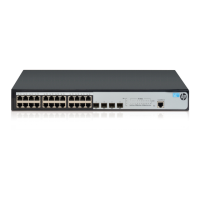242
Configuring ARP
Overview
ARP resolves IP addresses into MAC addresses on Ethernet networks.
ARP message format
ARP uses two types of messages: ARP request and ARP reply. Figure 216 shows the format of the ARP
request/reply messages. Numbers in the figure refer to field lengths.
Figure 216 ARP message format
• Hardware type—Hardware address type. The value 1 represents Ethernet.
• Protocol type—Type of the protocol address to be mapped. The hexadecimal value 0x0800
represents IP.
• Hardware address length and protocol address length—Length, in bytes, of a hardware address
and a protocol address. For an Ethernet address, the value of the hardware address length field is
6. For an IPv4 address, the value of the protocol address length field is 4.
• OP—Operation code, which describes type of the ARP message. Value 1 represents an ARP request,
and value 2 represents an ARP reply.
• Sender hardware address—Hardware address of the device sending the message.
• Sender protocol address—Protocol address of the device sending the message.
• Target hardware address—Hardware address of the device to which the message is being sent.
• Target protocol address—Protocol address of the device to which the message is being sent.
ARP operating mechanism
As shown in Figure 217, Host A and Host B are on the same subnet. Host A sends a packet to Host B as
follows:
1. Host A looks through its ARP table for an ARP entry for Host B. If one entry is found, Host A uses
the MAC address in the entry to encapsulate the IP packet into a data link layer frame. Then Host
A sends the frame to Host B.

